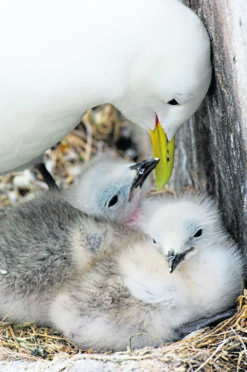Two species of Scotland’s iconic seabirds are booming on an island nature reserve.
An increase in the number of kittiwakes and great skuas – also known as bonxies – on Handa Island Wildlife Reserve has been recorded this summer by Scottish Wildlife Trust rangers.
An all-island count of kittiwake nests on the island, which lies off the west coast of Sutherland, recorded 3,749 nests. The last count showed an alarming decline, from 4,466 in 2009 to 2,715 in 2013.
A survey of great skua territories found at least 283 apparently occupied territories, a record compared to the previous highest count of 266 which was recorded in 2009.
Handa Ranger Craig Nisbet said: “It’s well known seabirds are in decline both nationally and globally. Good news stories are becoming less frequent as climate change impacts the availability of the food on which they are dependant. For that reason, we are particularly delighted to report an increase in both kittiwake and bonxie numbers on Handa this year.
“Seabird productivity is directly connected to the condition of the world’s oceans, so work to monitor their success is vital to understanding and protecting the habitat that supports them. We all need to be aware of the impact that climate change has on the world around us, and consider the importance of our oceans both to us, and our coastal seabird populations.”
The Handa Skua Project was started in 2003 by Dr Trevor Jones, who a travelled from his home in Tanzania to help with this year’s survey. The project aims to monitor the breeding success of great and Arctic skuas on the island, which is at the southern end of the global range for both species.
Kittiwakes are gulls that spend the winter out at sea and return to the coast to breed. Arctic and great skuas are known to defend their territories aggressively, and feed by stealing the food of other seabirds. Almost half of the global population of great skuas can be found in northern Scotland.
Both kittiwakes and Arctic skua are red-listed as Birds of Conservation Concern, meaning they have the highest conservation concern in the UK. Great skuas are amber-listed.
Handa Island Wildlife Reserve is owned by Scourie Estate and managed in partnership with the Scottish Wildlife Trust. Each summer the island comes alive with the sound of thousands of breeding kittiwakes, fulmars, guillemots, razorbills and puffins.
